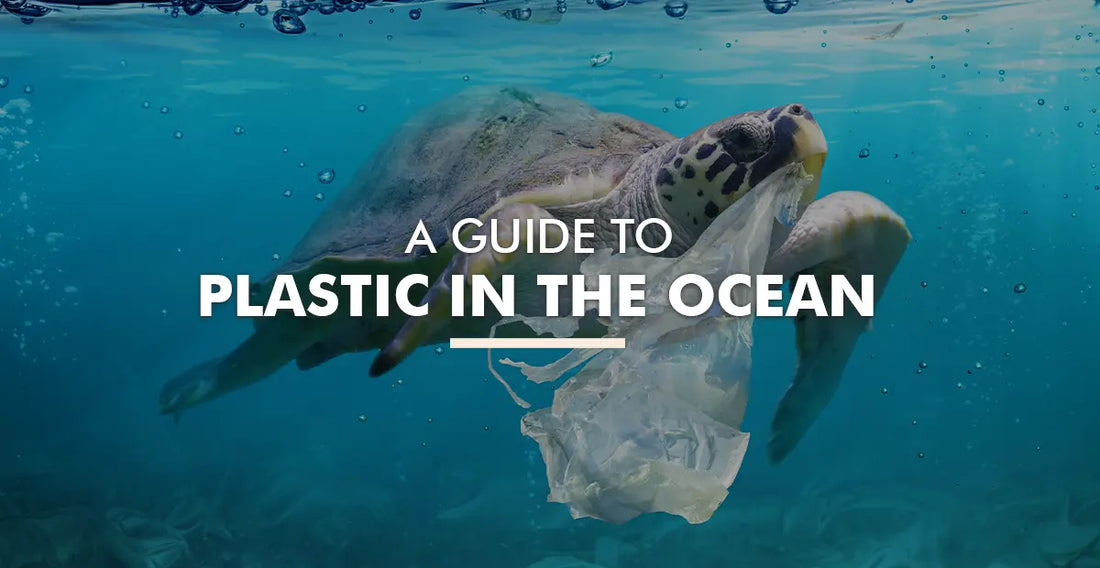
How Much Plastic Is in the Ocean? Unveiling the Shocking Facts
Share
Close your eyes and picture a tranquil beach with waves gently lapping at the shore. It's a peaceful scene, but lurking beneath the surface is an alarming truth - plastic pollution. How much plastic is in the ocean, you ask? Brace yourself, for the answer is as shocking as it is disheartening.
Beneath the surface of our majestic seas lies an underwater world inundated with plastic waste. Each year, an astonishing amount of plastic finds its way into the ocean, creating a grave threat to marine life and our environment. In this blog post, we'll embark on a revealing journey to uncover the shocking facts and figures surrounding ocean plastic pollution.
From the overwhelming quantity of plastic polluting our waters to its devastating impact on marine ecosystems, this is a call to action for all of us to protect our precious oceans. Let's dive into this pressing global challenge together and find ways to make a difference.
How Much Plastic Is in the Ocean 2023 Report

The 2023 report on ocean plastic pollution has revealed staggering figures that demand immediate attention and urgent action. Our oceans, once pristine and teeming with life, are now drowning in plastic waste, causing irreversible damage to marine ecosystems and threatening the delicate balance of life beneath the waves. Let's delve into the detailed findings of the 2023 report to understand the extent of plastic pollution in our oceans:
Marine Life Tragedy
More than 1 million seabirds and 100,000 marine animals succumb to plastic pollution each year. Shockingly, 100% of baby sea turtles have plastic in their stomachs, highlighting the dire consequences of plastic ingestion for vulnerable marine species.
Vast Quantity of Plastic
The report reveals that there are now 5.25 trillion macro and micro pieces of plastic in our oceans, with a staggering 46,000 pieces found in every square mile of the ocean. The weight of this plastic reaches up to a mind-boggling 269,000 tonnes, exacerbating the severity of the crisis.
Ongoing Plastic Influx
The report estimates that there is an alarming 75 to 199 million tons of plastic waste currently present in our oceans. Furthermore, a distressing 33 billion pounds of plastic enter the marine environment every single year, perpetuating the cycle of pollution.
Daily Plastic Influx
On a daily basis, approximately 8-10 million pieces of plastic make their way into our oceans, further contributing to the growing crisis.
Shocking Ocean Plastic Statistics
- More than 1 million seabirds and 100,000 marine animals die from plastic pollution every year.
- 100% of baby sea turtles have plastic in their stomachs.
- There is now 5.25 trillion macro and micro pieces of plastic in our ocean & 46,000 pieces in every square mile of ocean, weighing up to 269,000 tonnes.
- There is an estimated 75 to 199 million tons of plastic waste currently in our oceans, with a further 33 billion pounds of plastic entering the marine environment every single year.
- Every day around 8 million pieces of plastic makes their way into our oceans.
- The Great Pacific Garbage Patch is around 1.6 million square kilometers – bigger than Texas.
- The world produces 381 million tonnes of plastic waste yearly – this is set to double by 2034.
- 50% of this is single-use plastic & only 9% has ever been recycled.
- Over 2 million tonnes of plastic packaging are used in the UK each year.
- 88% of the sea's surface is polluted by plastic waste.
- Between 8 to 14 million tonnes enters our ocean every year.
- Britain contributes an estimated 1.7 million tonnes of plastic annually.
- The US contributes 38 million tonnes of plastic every year.
- Plastic packaging is the biggest culprit, resulting in 80 million tonnes of waste yearly from the US alone.
- On UK beaches there are 5000 pieces of plastic & 150 plastic bottles for each mile.
- More than 1 million plastic bags end up in the trash every minute.
- The world uses over 500 billion plastic bags a year – that’s 150 for each person on Earth.
- 8.3 billion plastic straws pollute the world’s beaches, but only 1% of straws end up as waste in the ocean.
- 1 in 3 fish caught for human consumption contains plastic.
- Plastic microbeads are estimated to be one million times more toxic than the seawater around it.
- Products containing microbeads can release 100,000 tiny beads with just one squeeze.
Great Pacific Garbage Patch
The notorious Great Pacific Garbage Patch spans a staggering 1.6 million square kilometers, making it larger than the state of Texas. This massive accumulation of plastic waste epitomizes the gravity of the issue on a global scale.
Increasing Plastic Production
The world currently produces 381 million tonnes of plastic waste annually, and this disconcerting figure is projected to double by the year 2034, exacerbating the already dire situation.
Fomin's Role in Creating a Plastic-free World

At Fomin, we're committed to a plastic-free future. With each purchase of our Eco-Clean Towels, Deodorant Wipes, Bathroom Refill Packs, and Hand Soap Sheets, you save 12 ocean-bound plastic bottles from polluting our precious oceans. Join us in the fight against plastic pollution and be a part of the positive change for our environment. Choose Fomin and make a difference today!
Single-Use Plastic Dominance
An alarming 50% of the plastic produced is single-use, leading to an overwhelming 80 million tonnes of plastic waste from the US alone, primarily due to plastic packaging.
Microplastics and Marine Life Impact
Microplastics are an emerging concern, with 88% of the sea's surface now polluted by these tiny particles. It is estimated that between 8 to 14 million tonnes of plastic enter our oceans each year, further contributing to the microplastic menace.
Global Contributions
The report highlights the global impact, with Britain contributing an estimated 1.7 million tonnes of plastic annually, while the US adds a staggering 38 million tonnes each year.
Widespread Plastic Pollution
There are 5000 pieces of plastic and 150 plastic bottles on UK beaches for each mile, underscoring the widespread nature of plastic pollution on coastlines.
Plastic Usage
The world uses over 500 billion plastic bags a year, translating to 150 bags for each person on Earth, adding to the immense plastic burden in our oceans.
Straws and Fish Contamination
A startling 8.3 billion plastic straws pollute the world's beaches, with 1 in 3 fish caught for human consumption containing plastic, highlighting the far-reaching impact on our food chain.
Microbeads Toxicity
Plastic microbeads, found in many personal care products, are estimated to be one million times more toxic than the surrounding seawater. Just one product can release 100,000 tiny beads, further contributing to ocean pollution.
The 2023 report on ocean plastic pollution serves as a clarion call for action. It emphasizes the urgency of addressing this global crisis through concerted efforts at individual, community, and governmental levels.
How Does Plastic Get Into the Ocean?

Plastic finds its way into the ocean through various pathways, most of which are a result of human activities. The main contributors to plastic pollution in the ocean include improper waste disposal, poor recycling practices, and industrial processes. Let's explore these pathways in detail:
Littering and Poor Waste Management
One of the primary sources of plastic pollution in the ocean is littering. When people discard plastic items like bottles, bags, and food containers irresponsibly on streets, beaches, or near water bodies, wind, and rain can carry them into storm drains, rivers, and, ultimately, the ocean. Additionally, inadequate waste management systems in some regions can lead to the improper disposal of plastic waste, allowing it to reach water bodies and oceans through waterways.
Plastic Waste from Landfills
Even when plastic waste is sent to landfills, it is not entirely contained. Over time, rainwater and other factors can cause plastic to escape from landfills and reach nearby rivers or coastal areas, eventually making its way into the ocean.
Beach and Recreational Activities
Beachgoers and tourists can unintentionally contribute to ocean plastic pollution. Items like plastic bags, bottles, and food containers left on beaches can be carried away by tides and currents, ending up in the ocean.
Sewage and Wastewater Discharge
Plastic particles and microplastics can also enter the ocean through sewage and wastewater systems. Microplastics, which are tiny plastic particles, can be found in personal care products like cosmetics and cleaning agents. When we use these products and wash them down the drain, microplastics can be carried through wastewater treatment plants and eventually reach the ocean.
Shipping and Fishing Activities
The shipping industry is a significant source of ocean plastic pollution. Lost or discarded fishing gear, known as "ghost gear," and other plastic items from ships can float on the ocean's surface or sink to the seafloor, causing harm to marine life.
Illegal Dumping at Sea
In some cases, unscrupulous operators may illegally dump plastic waste directly into the ocean to avoid disposal costs. This practice is highly detrimental to marine ecosystems and poses a severe threat to marine life.
Coastal Runoff
Rainwater and stormwater runoff from urban areas can pick up plastic debris from streets, sidewalks, and other surfaces, carrying it into rivers and streams that eventually lead to the ocean.
By curbing plastic usage, implementing effective waste management, and fostering a culture of environmental responsibility, we can collectively safeguard the health of our oceans and secure a sustainable future for marine life and humanity.
How much plastic is in the ocean?
- 8 million pieces of plastic pollution find their way into our ocean daily.
- Plastic has grown exponentially from 2 million tonnes per year in 1950 to 460 million metric tons in 2019.
- 79% of plastic waste is sent to landfills or the ocean, while only 9% is recycled, and 12% gets incinerated.
- 25 trillion macro & 51 trillion microplastics litter our oceans.
- By 2025, about 250 million metric tons of plastic will likely enter the oceans.
- Lost fishing gear, known as ghost gear, accounts for around 20% of all marine plastic.
- Most floating plastics can be traced back to 5 fishing nations: the US, Japan, South Korea, China, and Taiwan.
- Of that, 269,000 tonnes float on the surface.
- This is the equivalent of 1345 blue whales & 500 times the number of stars in our galaxy.
- 4 billion plastic microfibers per square kilometer clutter the sea.
- Between 4.8 and 12.7 million tonnes of plastic pieces are dumped into our oceans yearly.
- One garbage truck of plastic is discarded into our oceans every minute.
- Approximately 5,000 items of marine plastic pollution have been found per mile of beach in the UK.
- 165 million tonnes of plastic currently circulates in Earth's marine environments.
- Only 1% of marine litter floats, everything else sinks to the sea floor.
- Plastic has been found as far as 11km deep, contaminating the most remote places on Earth.
Frequently Asked Questions
How Much Plastic Is in the Ocean Each Year?
Approximately 14 million tons of plastic are dumped into the ocean each year, posing a grave threat to marine life and our planet's fragile ecosystems.
How Much Plastic Is in the Ocean in 2023?
As of 2023, the ocean is estimated to contain a staggering 5.25 trillion macro and micro pieces of plastic, weighing up to 269,000 tonnes, causing irreversible damage to marine ecosystems.
How Much Plastic Will Be in the Ocean by 2050?
By 2050, it is projected that there will be around 850-950 million tonnes of plastic in the ocean. If current trends continue, there is a concerning possibility that there could be more plastic than fish in the ocean by that time.


